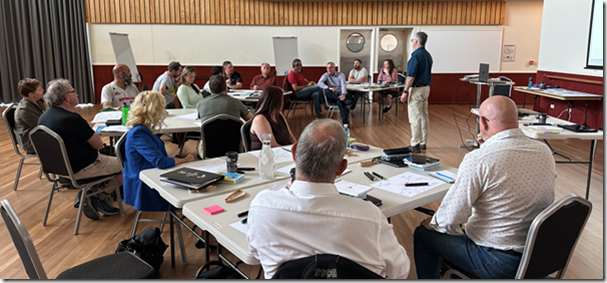It was great to see some new and old faces as we commenced our workshops on Mythology and Embodiment in risk. Craig did some great groundwork on Concept Mapping myth and the Linguistics of myth as well as work on models and the myth of the Scientific Method. I started out by exploring Myths at 4 levels International, National, Local and Personal myths with case studies in each to show how myth is made.
It is important to understand what myth is as most misunderstand it as fable, fairy tale or legend and this is not the case. Myth is its own unique genre but stands apart from other forms of knowing based on evidence and practice. Myth is a unique way of understanding story, semiotics, narrative, discourse, meaning-making (semiosis) and cultural belief systems. If one doesn’t include a study of myth in an understanding of culture, one is NOT talking about culture.
Myths are neither good or bad, rational or irrational but rather a non-rational way of knowing using faith-belief in knowing. One of the case studies for example, was of the Simpson and his Donkey Myth, a National icon and symbol for heroics, mateship and heroism but none of it is true. Yet, statues, coins, stamps and other memorabilia exist that symbolically maintain the myth. Most myth is maintained this way including many safety myths (https://safetyrisk.net/the-power-of-safety-myths/).
And, it doesn’t matter what myth-busting is published (eg. Wilson, Dust, Donkeys and Delusions, The Myth of Simpson and his Donkey), myths do NOT go away or disappear. This is because all myth is founded on an ethic of faith-belief that is neither rational or irrational.
Once a myth has been given symbolic power it is nearly impossible to take it away. This is why Safety keeps inventing new myths upon myths as it discovers that the previous myth didn’t work.
It wouldn’t matter what evidence was provided to demonstrate that the Swiss-cheese, risk matrix, bow-tie, Bradley Curve or Heinrich’s pyramid were myths, they will still be believed as efficacious. Faith in these myths in Safety is institutionalised, believed in faith, attributed with power and infused with symbolic and political power.
Myth-busing in Safety is understood NOT as demonstrating evidence of reality but demonised as being anti-safety.
This is how all religions work.
The real test of any myth is its ethical outcome and Safety seems to have no interest in such. Indeed, in the AIHS BoK Chapter on Ethics there is no mention of power, zero, culture, myth or and ethic of risk. It is just a defence of deontological ethics best suited for blind compliance but, it is says very little about Ethics.
When we look at these models (symbolic metaphors) that are used in safety it is clear that this semiotics have more in common with art than science. None of these models are ‘objective’, they cannot be. Neither can any of these models contribute to measurement, the great love of safety. Neither can any of these models help with understanding ‘controls’, the second great love of safety. What happens in these semiotic metaphors used by safety is the creation of attachment through symbolic faith that then becomes a marker for political belonging. And, if you criticise myth you are quickly ousted politically. Eg. criticise zero in a zero organisation and see how long you will last.
There is however alternative to myths that are neither ethical nor effective but these rely on a very different ethic and methodology in which safety shows little interest. The methods offered by SPoR not only work (https://www.humandymensions.com/product/it-works-a-new-approach-to-risk-and-safety-book-for-free-download/) but are practical, positive and humanise tackling risk in the workplace.






Matt Thorne says
With so many parts to culture, how can organisations continue to ignore myths, rituals and embodiment?